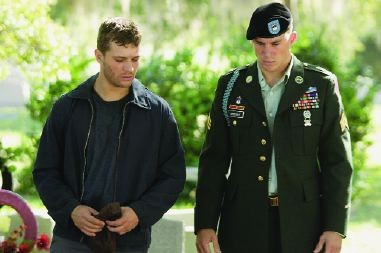Stop-Loss

Staff Sergeant Brandon King (Ryan Phillippe) thinks Tikrit will be the last stop on his tour of duty in Iraq. It’s a bad finish: he leads his men into an ambush. He loses three of them and another winds up blind and crippled. When Brandon and his childhood friend Steve Shriver (Channing Tatum) return to their Texas hometown, they’re proclaimed war heroes. Brandon can’t wait to put the war behind him. Then he learns that he’s been “stop-lossed”—that is, his service has been extended beyond the normal time period because of the military’s need for troops.
Stop-Loss is director Kimberly Peirce’s first movie in nine years (her previous film was Boys Don’t Cry), and you can see that she cares deeply about the subject matter. The film’s tone is a mix of sadness and outrage, and it aims to cover a lot of ground. Peirce and co-writer Mark Richard use Brandon, Steve and their friend Tommy Burgess (Joseph Gordon-Levitt)—and, briefly, Rico Rodriguez (Victor Rasuk), the private wounded in the ambush—to convey a range of postwar experiences.
Peirce’s models are the great 1946 picture The Best Years of Our Lives, which accompanied World War II veterans returning to middle America, and The Deer Hunter (1978), which followed buddies from a Pennsylvania steel town who had fought together in Vietnam. But those films had the luxury of three-hour running times. Stop-Loss packs in so much emotional turbulence in under two hours that it feels more like melodrama than drama.
Brandon, Steve and Tommy all suffer from posttraumatic stress that leads to a variety of destructive and self-destructive behaviors. On their first night home, Tommy’s marriage breaks up, and when Steve, drunk and believing he’s back in Iraq, starts to dig trenches in his back yard and beats up his girlfriend Michelle (Abbie Cornish), she walks out on him. Brandon, too, re-creates the wartime scenes that haunt his memories. The way the characters repeat each other’s behavior makes the film seem repetitive as well as overheated.
When Brandon goes AWOL, he taps into the underground world of stop-lossed soldiers trying to escape a third tour. At a cheap motel en route to Canada he encounters a fugitive soldier unable to get medical help for his family. It’s hard to believe that the filmmakers throw in a sick kid to up the emotional ante, as if dealing with Iraq and PTSD weren’t enough. It’s like adding The Grapes of Wrath on top of The Deer Hunter.
Also preposterous is a flashback to the ambush in which an insurgent holds his young son in his arms while he shoots at Brandon and Steve, forcing Brandon to fire back on the man and his child.
Peirce and Richard are so set on ratcheting up the movie’s message that they don’t seem to have bothered to think through the plot. Brandon’s first thought when he decides to walk away from the army is to contact the senator (Josef Sommer) who promised him assistance when he came home a hero; it doesn’t seem to occur to him that a representative of the U.S. government isn’t likely to open his office to an AWOL soldier.
Phillippe and Cornish give perfectly creditable performances, and Gordon-Levitt brings a spooky presence to an underwritten role. But most of the acting is strictly by the book, and none of the performances linger after the picture is over. The Iraq scenes are impressively shot (by Chris Menges) and edited (by Claire Simpson), but they aren’t fluid or visceral; they look staged. Peirce’s direction relaxes once she gets to Texas, but not for long—there’s hardly a moment that doesn’t try to score a point.
Clearly the film wants to explore the experiences of Iraq war vets, but you feel you’ve seen these dramatic situations before. Even a movie as topical as this one can’t get at its subject if it isn’t grounded in narrative logic and the psychological truth of someone’s real experience—not just in the experience of watching other, better movies about war.





